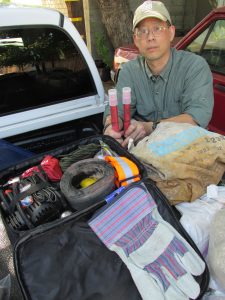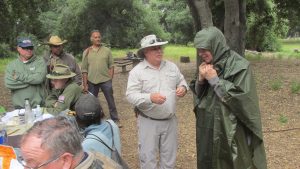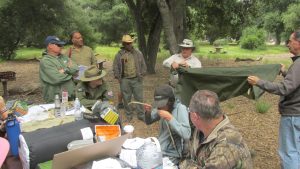By Christopher Nyerges
[Nyerges is the author of “Urban Survival Guide,” “Extreme Simplicity: Homesteading in the City,” “How to Survive Anywhere,” and other books on survival and self-reliance. For more information on his classes and books, go to www.SchoolofSelf-Reliance.com, or Box 41834, Eagle Rock, CA 90041.]
HOW TO PREPARE FOR EMERGENCIES.
VARIOUS APPROACHES
We’re always talking about “being prepared” but what does that actually mean, in practice? Does everyone prepare the same way? Of course not. Everyone’s situation is always just a little bit different, depending on many factors. Your planning and prepping should reflect your unique life situation. And even if this may seem obvious to some of you , let’s look at the factors that go into emergency planning.
YOUR HOUSEHOLD
The size and makeup of your household has a lot to do with your planning. Do you live alone? Are you strong and fit? Does your household include elderly, children, or those with special medical needs? Is everyone you live with all on the same page when it comes to how to be prepared for an emergency? (This is rarely the case).
I suggest you make a list of all the “must-have” needs for YOUR family, and make sure you always have extra of those items.
YOUR LOCATION
Do you live in an urban area, or in a rural area? Or do you live somewhere in-between, in suburbia? Do you know your neighbors? Are you involved with community groups? Do you have a sense of the people who live around you? Does your location experience regular deep cold or very hot conditions? Is your area prone to flooding? Do you live in an isolated area?
So, although we can agree that there are certain basics that can apply to everyone everywhere, the WHO and the WHERE of your situations are going to be the key factors for how you go about your specific planning.
I suggest you keep a map on the wall of YOUR area, and list all the likely emergencies that you should do what you can to be ready for. This includes the supplies you need, the possibility of evacuation, and the need to stay in touch with your neighbors.
GEAR VS. EXPERIENCE
I have found that the topic of “preparedness” involves two things: the gear that you all love, and actual real world experiences. I know a lot of guys will bristle at what I am about to say, but if I had to choose how to use my limited resources to buy stuff, or to pay for classes, I would choose the latter in a heartbeat. That’s my hard opinion. Stuff can get lost, stolen, or forgotten. And I know too many guys who have so much stuff, in boxes, in storage spaces, that they’d not be likely to get to what they need when Armageddon actually descends. I am not against stuff, but your learning is yours, and with knowledge, you can actually adapt the material stuff of the world to ensure your survival.
SPECIFICS
Since we are not defining a specific “survival situation” here, you can use your imagination to see what sorts of situations have happened in your area in the past, and attempt to be prepared for that. For example, natural disasters include flooding, high winds, tornadoes, wild fires, earthquakes, drought, etc. Man-made disasters include economic downturns, riots for various causes, civil war, war by invasion, deadly fumes from factories, spilled chemicals, etc.
There are a lot of threats to our health and safety, and it’s nearly impossible to prepare for everything. But knowing your local area makes a big difference, since part of your planning will be to evacuate, or figure out how to stay safe in place.
WHAT THE EXPERTS SAY
I posed this question about how to set survival priorities to a variety of individuals. I wanted to learn how others approached the topic. Some that I spoke to are experts in their fields, and some simply live with their families and want to be safe. I told them that I’d like to hear whatever they felt was important both in terms of the “big picture” and in terms of not letting “little things” turn into major disasters. Here are some of their varied responses:
BARTON BOEHM
Barton Boehm is a martial arts master who did his training in Japan under harsh conditions. He authored the book, “Lessons from a 21st Century Samurai: The Seiken Way.” He is currently retired but still does some limited martial arts training.
He tells me, “In order to answer the question, how to prioritize survival, one needs to answer the question what does one mean by survival? Everyone will have a slightly different answer.
And then, no matter how much you prioritize or prepare, things will never happen how you imagined! I speak from experience.
“With this thought in mind I offer the following suggestions:
First, survival is not a matter of preparation or priority. It is a way of living your life deliberately and in full awareness of what is most important to you.
Second, we survive collectively and not as individuals. It’s imperative we think ‘prepare to share, not to prepare to survive.’
Third, the more we think of how to help, the better our we can prioritize and what to prepare for.
The actual preparations that each person does is academic and will automatically unfold before you.”
I found myself agreeing with Boehm in the larger sense that you should find a way to live y our life deliberately will full awareness in order to be the most prepared for anything.
KEITH FARRAR
Then I spoke with Keith Farrar, a family man and a survival skills instructor. He developed a teaching system to help students consider survival priorities. Farrar’s perspective is that while our environments change, our needs do not. He believes that we do not need to re-think our priorities in different environments. “While the items we put into our kit to address those priorities may differ from environment to environment, the priorities and how we address them do not change,” he explains.
“I have never been a fan of survival instructors that give a list of survival gear to carry,” he explains, “because you wind up with a bunch of stuff where you may or may not know their given purpose. Teaching the priorities in a survival situation and allowing the student to put into their kit whatever tools they are comfortable using to address each of the priorities makes more sense.”
“I follow the ‘Rule of 3s.’ However, I have added in two very important concepts that make the Rule of 3’s a complete survival system. Lastly I look at the “10 Essentials” which is a list of gear to carry created in the 1930s by the mountaineering group called “The Mountaineers”.
“The ‘Rule of 3s’ are used like a pilot’s checklist, meaning if that priority is covered, you go on to the next priority. The first aid priority is a good example; it is very high up on the list, however, if you have no life threatening or major issues (severe bleeding or anaphylaxis for example), you move on to your next priority.
“The original ‘Rule of 3s’ covers how long you can live without addressing important survival needs:
- Three seconds without “Hope”: This means a positive mental attitude, the will to live. Yes you will not die after 3 seconds without hope, however this sets the tone for your survival situation.
- Three minutes without “Air”: While I am amazed at how many survival instructors think this only relates to “air”, meaning drowning, the reality is “Air” is a metaphor for bodily functions, meaning any life threatening First Aid issue where you stop breathing.
Carry: A first aid kit with items you know how to use. Take a wilderness first aid class.
- Three minutes without “Shelter”: This is thermoregulation (keeping your body core temperature at 98.6 degrees). This is addressed with shelter and fire.
Carry: Tarp shelter or poncho, cordage, lighter, matches, ferro rod, fire starting material, knife (to help process wood)
- Three days without “Water”: While you may perish in less than 3 days in the desert, or live longer than 3 days in cold & moist environments, this priority certainly comes after shelter.
Carry: water container, water filter, water purification chemical, metal container to boil water.
- Three weeks without “Food”: You may get hungry and grumpy, however you will not die without food. It is a low priority.
Carry: Extra food, trail snacks, snare wire, the knowledge of trapping and processing small game.”
Farrar also believes that signaling and navigation should be considered, in order to have a complete system.
DOCTOR P:
If I stayed at home in my condo (after some emergency), I’d fill the bathtub with water, have a few 5 gallon buckets for toilets, lots of TP and or alcohol and rags for hygiene, beans, rice, or MRE’s, guns and lots of bullets, some bleach to add to the water in the tub and back of toilet for cooking and drinking, have a dozen 3-day candles, and stock up on antibiotics (you can use the ones for animals from feed stores; I like valleyvet.com). If you have medical needs, stock up.”
Dr. P has a bug-out bag that contains food, water, water purification tablets, flashlight, supplies for shelter and warms, a variety of tools (including rope and fire-starters), as well as hygiene and first-aid supplies.
JAMES RUTHER
According to lifelong wilderness explorer and bushcrafter James Ruther, “I set my priorities by the age-old ‘rule of 3,’ and I build my kits around it.”
Ruther makes his survival kits based on the Rule of 3, as explained above.
According to Ruther, “My first line of defense is my clothes and what’s in my pockets. So I carry my EDC pocket knife, mini multitool, ferro rod, lighter, and fresnel lens. When I am day hiking, I carry a fixed knife, 32 oz water bottle, space blanket, and a Silky Pocketboy saw. Then I have more in my car, where I carry my ‘get home’ or 72 hour kit. In all my kits, I carry enough for two. In the car, I have always carried a hatchet, a bow saw, and a shovel. I have had to use all three tools in the past to get me out sticky situations. Heavy storms bring down trees where the hatchet and saw come in handy. Sometimes you’re driving off road and get stuck and that’s where the shovel come in handy.”
Ruther goes on to say that “The most exciting 4×4 driving I have ever done was going fishing with a couple of ‘old guys’ in an 80s vintage Datsun B210. One of the guys would look at the other and ask if they should try the next section of road, to which he’d reply ‘Do we have the shovel?’ which was the deciding factor to go or not.”
JULIA HAN, a professional living and working in Los Angeles:
Since Han is the only person I spoke to who lives in the heart of Los Angeles, I found her comments most useful and insightful.
She says “Because I live in a dense urban area of Los Angeles, there are advantages with the close proximity to people and supplies. But the disadvantages are that I don’t have a lot of space to store things and that I rely heavily on municipal infrastructure and stores for basic needs. I drive on the roads of LA on a daily basis and I work in a high rise, and both environments have their own set of risks. I rent a small studio ADU which limits my ability to store/grow food and store/collect water. I live in the middle of the city, so I don’t have immediate access to natural sources for water, plants, and other materials.
“Therefore, my survival priorities are as follows:
1) People: In the urban environment, I think the top priority is recognizing the importance of working with people in any emergency situation. I try to build and maintain good relations with my neighbors, and take advantage of opportunities to engage with my community, such as through my community garden.
2) Being alert, cautious, and observant: This is true on a daily basis in the city, but even more so during major events. I try to be constantly aware of who is around me, who might need help, and take common sense precautions.
3) Skill-building: One advantage of living where I live is the abundant opportunity for hands-on learning. I go to local survival classes, foraging/ethnobotany classes, and I took the CERT training, all of which have been so helpful. I also plan to take Angelo Cerveras’ highly recommended self-defense classes.
4) Planning for infrastructure failure: I do what I can with the following, but in my situation, I know that “prepping” itself may be useless without the priorities mentioned above.
- water: storing what I can, knowing my nearest water sources, having methods of purification
- power: storing non-electrical sources for warmth, cooking, and light, as well as solar-charged battery for small devices
- travel: bicycle as alternative to vehicle, city/regional map (street and topographic)
- safety/medical: first aid supplies, protective equipment, basic training in bleeding control, CPR, and administering first aid
- information: hand-crank radio”
CONCLUSION
You can’t go wrong by giving the Rule of 3 and the 10 Essentials serious consideration. But also, look through the lens of YOUR family in YOUR location, since every situation is unique, and will require a unique approach so that you get through it safely and in good health.
Everyone listed above has a deep involvement in practical day to day survival, and so their comments are well worth noting.
PHOTOS [ALL BY CHRISTOPHER NYERGES UNLESS OTHERWISE INDICATED]












